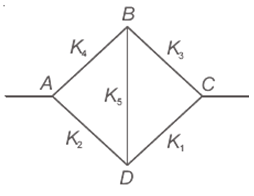A slab consists of two parallel layers of two different materials of same thickness having thermal conductivities K1 and K2. The equivalent conductivity of the combination is
Solution:
Given:
- Layer 1: Thermal conductivity \(K_1\)
- Layer 2: Thermal conductivity \(K_2\)
- Thickness of each layer: \(d\)
Formula for Equivalent Thermal Conductivity
The equivalent thermal conductivity for two parallel layers of the same thickness can be given by:
\[
K_{eq} = \frac{K_1 + K_2}{2}
\]
Derivation:
1. Resistance of Each Layer:
The thermal resistance for each layer can be expressed as:
\[
R_1 = \frac{d}{K_1 A}, \quad R_2 = \frac{d}{K_2 A}
\]
where \(A\) is the cross-sectional area.
2. Total Resistance in Parallel:
The total resistance for two resistors in parallel is:
\[
\frac{1}{R_{eq}} = \frac{1}{R_1} + \frac{1}{R_2}
\]
Substituting the resistances, we get:
\[
\frac{1}{R_{eq}} = \frac{K_1 A}{d} + \frac{K_2 A}{d}
\]
Simplifying:
\[
\frac{1}{R_{eq}} = \frac{A}{d} \left(K_1 + K_2\right)
\]
3. Total Conductivity:
Now, the equivalent conductivity can be expressed as:
\[
K_{eq} = \frac{d}{A} \cdot \frac{1}{R_{eq}} = \frac{d}{A} \cdot \frac{d}{A (K_1 + K_2)} = \frac{K_1 + K_2}{2}
\]
Conclusion:
Thus, for two parallel layers of materials with equal thickness, the correct equivalent thermal conductivity is:
\[
K_{eq} = \frac{K_1 + K_2}{2}
\]
